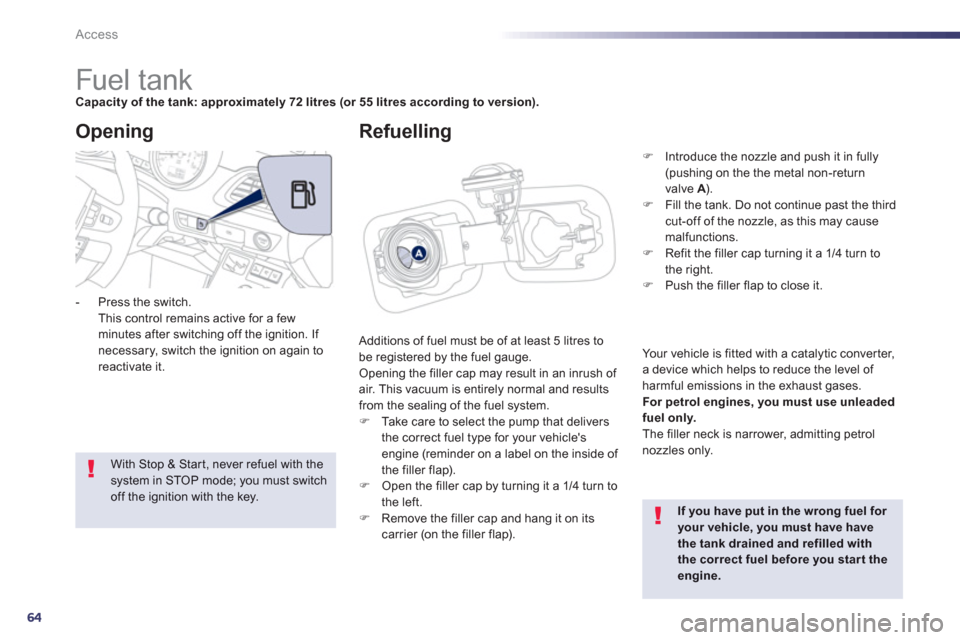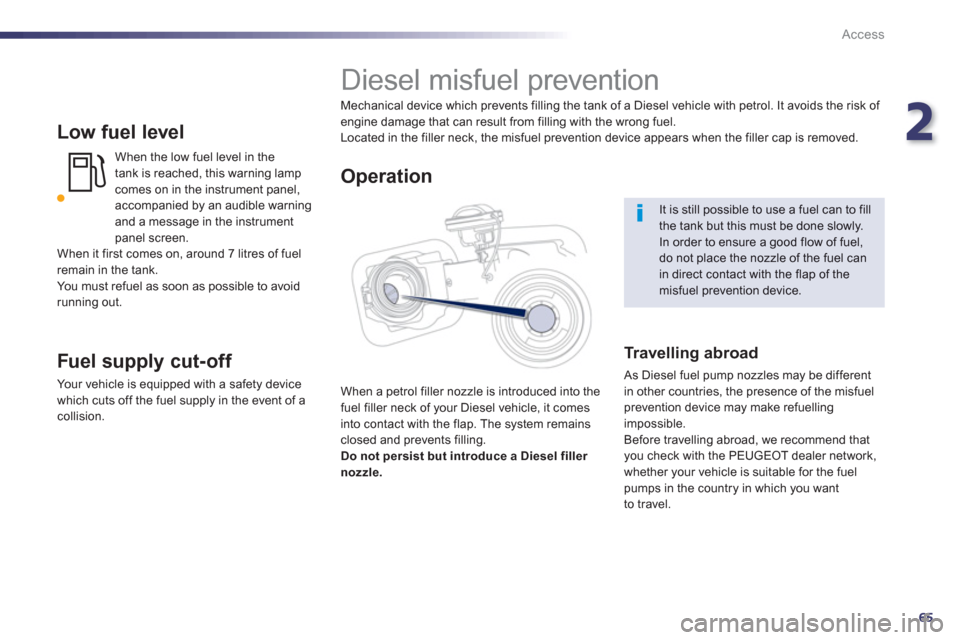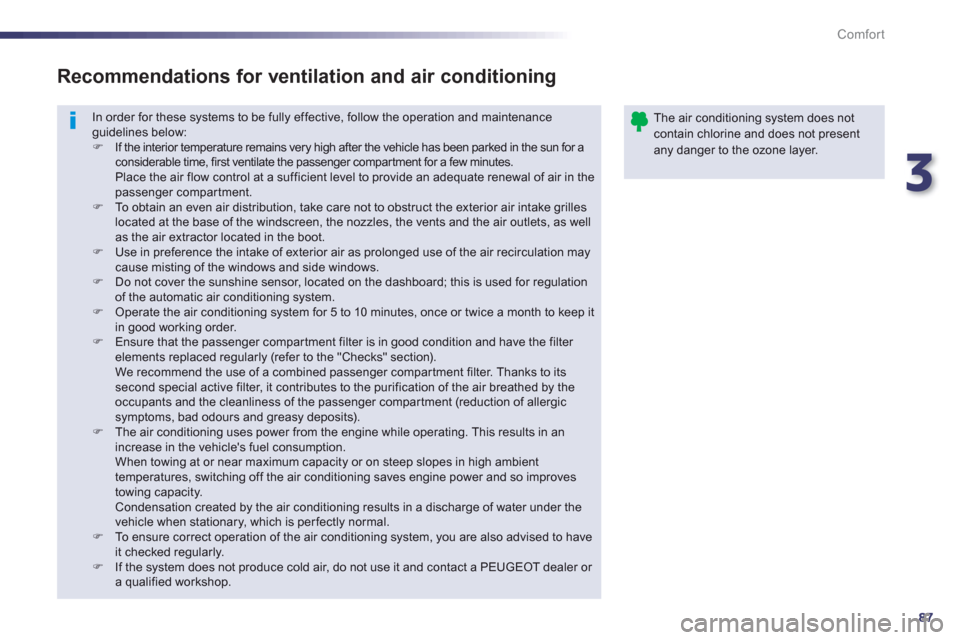Page 8 of 340
6
Familiarisation
Open
A.
Unfolding / Folding the key.B.Unlocking the vehicle.
Remote control key
1.
Opening the fuel filler flap.
Fuel t ank
64
Unlocking
With the electronic key on your person and in the
defined zone around the vehicle, pass your hand behind the door handle to unlock the vehicle,
then pull on the handle to open the door.
Locking
With the electronic key in the defined zone
around the vehicle, press with a finger on
the door handle (at the markings) to lock the
vehicle.
Keyless Entry and Starting
system
2.Opening and hooking the fuel filler cap.
Ta n k c a p a c i ty: approximately 72 litres (or 55 litres according to version).
Other functions...C.Normal locking of the vehicle Vehic le location.
44
43
Page 66 of 340

64
Access
Fuel tank Capacity of the tank: approximately 72 litres(or 55 litres according to version).
Additions of fuel must be of at least 5 litres to be registered by the fuel gauge.
Opening the filler cap may result in an inrush of
air. This vacuum is entirely normal and results
from the sealing of the fuel system.F Take care to select the pump that delivers
the correct fuel type for your vehicle'sengine (reminder on a label on the inside of
the filler flap).F Open the filler cap by turning it a 1/4 turn to
the left. F Remove the filler cap and hang it on its
carrier (on the filler flap).
Opening
If you have put in the wrong fuel for your vehicle, you must have have the tank drained and refilled with the correct fuel before you star t theengine.
With Stop & Star t, never refuel with the system in STOP mode; you must switch off the ignition with the key. - Pr
ess the switch.
This control remains active for a few minutes after switching off the ignition. If necessary, switch the ignition on again toreactivate it.
Refuelling
F
Introduce the nozzle and push it in fully
(pushing on the the metal non-return
valve A).AF Fill the tank. Do not continue past the thirdcut-off of the nozzle, as this may causemalfunctions. F
Refit the filler cap turning it a 1/4 turn to
the right.F Push the filler flap to close it.
Your vehicle is
fitted with a catalytic converter,
a device which helps to reduce the level of harmful emissions in the exhaust gases.
For petrol engines, you must useunleaded fuel only. The filler neck is narrower, admitting petrolnozzles only.
Page 67 of 340

2
65
Access
Low fuel level
When the low fuel level in the
tank is reached, this warning lamp comes on in the instrument panel, accompanied by an audible warning and a message in the instrument panel screen.
When it first comes on, around 7 litres of fuel
r
emain in the tank.
You must refuel as soon as possible to avoid
runnin
g out.
Fuel supply cut-off
Your vehicle is equipped with a safety device
which cuts off the fuel supply in the event of a collision.
It is still possible to use a fuel can to fill
the tank but this must be done slowly. In order to ensure a good flow of fuel, do not place the nozzle of the fuel can in direct contact with the flap of themisfuel prevention device.
Diesel misfuel prevention
Mechanical device which prevents filling the tank of a Diesel vehicle with petrol. It avoids the risk of
engine damage that can result from filling with the wrong fuel.
Located in the filler neck, the misfuel prevention device appears when the filler cap is removed.
When a petrol
filler nozzle is introduced into the fuel filler neck of your Diesel vehicle, it comesinto contact with the flap. The system remains
closed and prevents filling. Do not persist but introduce a Diesel filler
nozzle.
Operation
Tr a v e l l i ng abroad
As Diesel fuel pump nozzles may be different
in other countries, the presence of the misfuel
prevention device may make refuellingimpossible.
Before travelling abroad, we recommend that you check with the PEUGEOT dealer network,
whether your vehicle is suitable for the fuel
pumps in the country in which you want
to travel.
Page 89 of 340

3
87
Comfort
In order for these systems to be fully effective, follow the operation and maintenance guidelines below: F
If the interior temperature remains very high after the vehicle has been parked in the sun for a considerable time, first ventilate the passenger compar tment for a few minutes. Place the air flow control at a sufficient level to provide an adequate renewal of air in the passenger compartment.F
To obtain an even air distribution, take care not to obstruct the exterior air intake grilles located at the base of the windscreen, the nozzles, the vents and the air outlets, as wellas the air extractor located in the boot. F
Use in preference the intake of exterior air as prolonged use of the air recirculation maycause misting of the windows and side windows.F
Do not cover the sunshine sensor, located on the dashboard; this is used for regulation of the automatic air conditioning system.F
Operate the air conditioning system for 5 to 10 minutes, once or twice a month to keep itin good working order. F
Ensure that the passenger compar tment filter is in good condition and have the filter elements replaced regularly (refer to the "Checks" section). We recommend the use of a combined passenger compartment filter. Thanks to its second special active filter, it contributes to the purification of the air breathed by the occupants and the cleanliness of the passenger compartment (reduction of allergic symptoms, bad odours and greasy deposits).F
The air conditioning uses power from the engine while operating. This results in anincrease in the vehicle's fuel consumption. When towing at or near maximum capacity or on steep slopes in high ambient temperatures, switching off the air conditioning saves engine power and so improvestowing capacity. Condensation created by the air conditioning results in a discharge of water under thevehicle when stationary, which is per fectly normal.F
To ensure correct operation of the air conditioning system, you are also advised to haveit checked regularly.F
If the system does not produce cold air, do not use it and contact a PEUGEOT dealer or a qualified workshop.
Recommendations for ventilation and air conditioning
The air conditioning system does notcontain chlorine and does not present any danger to the ozone layer.
Page 222 of 340
220
Checks
checking the levels of the various fluids, for replacing cer tain components and for primingthe fuel system.
*
Accordin
g to engine.
Diesel engines
1.
Power steering reservoir.2.
Screenwash and headlamp wash reservoir.3.
Coolant reservoir. 4.
Brake fluid reservoir.5.
Battery / Fuses.
6.Fusebox.
7. Air filter.8.Engine oil dipstick. 9.
Engine oil filler cap.10.Priming pump * . 11.
Bleed screw *
. 1.6 litre HDi 110 hp
2.0 litre HDi 140 hp
Page 223 of 340
9
221
Checks
The various caps and covers allow access for checking the levels of the various fluids, for
replacing cer tain components and for primingthe fuel system.
*
According to engine.
Diesel engines
1.
Power steering reservoir.2.Screenwash and headlamp wash reservoir.3.Coolant reservoir.4.
Brake fluid reservoir.
5. Battery / Fuses.
6.Fusebox.
7. Air filter.8.Engine oil dipstick.9.
Engine oil filler cap.10.Priming pump * . 11.
Bleed screw *
. 2.0 litre HDi 163 hp
2.2 litre HDi 200 hp
Page 229 of 340
10
227
Technical data
Petrol engines1.6 litre VTi120 hp1.6 litre THP15 6 hp1.6 litre THP 160 hp
Gearboxes
Electronic gear control (6-speed)Manual (6-speed)
Automatic (6-speed)
Manual (6-speed)
Model codes8D5FH8/P - 8E5FH8/P8D5FS8/P - 8E5FS8/P 8D5FV8 - 8E5FV8 8D5FNA - 8E5FNA 8D5FVA - 8E5FVA -
Cubic capacity (cc) 1 598
1 598
1 598
Bore x stroke
(mm) 77 x 85.8 77 x 85.8
77 x 85.8
Max power: EU standard
(kW) 8588
11 0115-
Max power engine speed (rpm) 6 000
6 000
-
Max torque: EU standard
(Nm)
160 240 -
Max torque engine speed (rpm)
4 250
1 400
-
Fuel Unleaded Unleaded Unleaded
Catal
ytic converter yes
yes
yes
Oil capacities (in litres
)
Engine (with filter replacement)
4.25
4.25
4.25
Petrol engines and gearboxes
Page 233 of 340
10
231
Technical data
Diesel engines2.0 litre HDi 140 hp2.0 litre HDi163 hp
GearboxesManual (6-speed)
Automatic
(6-speed)Manual (6-speed)
Model codes8DRHR8 - 8ERHR8 8DRHF8 - 8ERHF88DRHHA - 8ERHHA
8DRHDA - 8ERHDA
8DRHH8 - 8ERHH8
BodySaloon
SW
SaloonSW Saloon
SW
Cubic capacity (cc) 1 997
1 997
Bore x stroke
(mm) 85 x 88
85 x 88
Max power: EU standard (kW)
10 0
103 10 0
120
Max power en
gine speed (rpm)
4 000
3 750
Max torque: EU standard (Nm)
320340
Max torque engine speed (rpm)
2 000
2 000
Fuel Diesel
Catalytic converter
yes
Particle emission filter yes
no
Oil capacities
(in litres)
Engine (with filter replacement) 5.255
Diesel engines and gearboxes